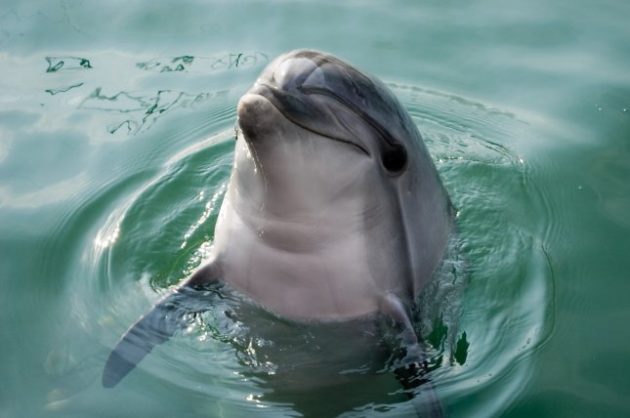By Simon Druker
The Russian navy has deployed its unit of trained military dolphins in the Black Sea as part of its ongoing war in Ukraine, satellite imagery published Thursday by the U.S. Naval Institute shows.
The USNI examined time lapse satellite imagery provided by Colorado-based Maxar Technologies, which shows two separate pens built near the entrance to Russia’s naval base on the Black Sea.
The two pens are located just inside a seawall at the Sevastopol harbor, near the main naval base used by Russia’s Black Sea Fleet. Russia took control of the base after its 2014 annexation of the Crimean Peninsula.
It’s not known how many dolphins make up the unit, or exactly what duties they’ll be tasked with.
Russia has a lengthy history of training the animals to carry out military tasks.
During the Cold War, the Soviet Union trained dolphins at the research oceanarium in Cossack Bay to detect mines and carry explosive charges able to detonate on contact with enemy ships. Soviet trainers reportedly claimed their animals could distinguish between friendly or enemy submarine engine noises.
With the fall of the Soviet Union in 1991, the oceanarium in Sevastopol came under the jurisdiction of Ukraine, and the number of marine animals dropped drastically. At the time, those animals also included beluga whales and sea lions in addition to the bottlenose dolphins.
In 2000, Crimean officials sold 27 dolphins, Beluga whales, walruses and sea lions to Iran.
A report at the time said the program was too expensive to continue, but that the animals were “trained to kill enemy divers and blow up ships.” They were eventually transferred to an undisclosed Iranian base on the Persian Gulf. Ukraine continued to wind the program down, barely keeping it open.
Following Russia’s 2014 annexation of Crimea, the base once again was controlled by the Russian Navy, including the dolphin combat unit.
At the time, the navy said the animals would be “preserved and redirected towards the interests of the Russian Navy.”
Ukraine later demanded the return of the entire dolphin unit in July 2014. Authorities said they had an aquarium where the dolphins could live for the summer until a new permanent home could be found for them.
Russia countered by saying it would not return the elite sea mammal unit. Instead, the country said it would train the finned soldiers to search for sunken military equipment and detect enemy divers, a program beyond Ukraine’s financial capabilities.
“Engineers are developing new aquarium technologies for new programs to more efficiently use dolphins underwater,” a Russian military source told state-run RIA Novosti at the time.
“Our specialists developed new devices that convert dolphins’ underwater sonar detection of targets into a signal to the operator’s monitor. The Ukrainian navy lacked funds for such know-how, and some projects had to be mothballed.”
In March of 2016, the Russian military tendered a contract to purchase five bottlenose dolphins for military purposes. It offered the equivalent of $25,000 in a notice posted on by the Russian Defense Ministry on the government’s procurement website.
The notice stipulated there must be three male and two female dolphins between the ages of 3 and 5. The length of the mammals’ bodies was not permitted to exceed 2.7 meters, which is the average size for the species. Prior to any sale, estimates put the number of existing dolphins at the facility at no more than 10.
At the time, military sources indicated the oceanarium in Sevastopol was receiving more manpower, including the transfer of some troops from Moscow military units, a sign Russia was once again ramping up its marine mammal training program.
The country has a similar animal program operating in the Arctic, using beluga whales and seals rather than the bottlenose dolphins used in the Black Sea. The belugas and seals are better insulated against cold temperatures.
In 2019, a beluga surfaced off the coast of Norway wearing a Russian military harness and mounted camera. Norway’s intelligence agency later concluded the whale was likely part of a Russian research program.
The United States is the only other country known to use dolphins for military purposes.
In 2018, the U.S. Navy’s Marine Mammal Systems Program participated in mine clearance training during the Rim of the Pacific exercise.
The dolphins, known as Mark 7 Marine Mammal Systems, are part of the U.S. Navy Marine Mammal program based out of Naval Base Loma, Calif. Technicians directed the dolphins to detect and mark simulated mines as part of RIMPAC SOCAL, the Navy said at the time.
The exact role for Russia’s dolphins isn’t entirely clear.
Russian navy ships with high strategic values are out of range of Ukrainian missiles but vulnerable to undersea sabotage. The dolphins could be tasked with counter-diver operations to prevent Ukrainian special operations forces from infiltrating the harbor underwater to sabotage the warships.
https://www.upi.com/Top_News/World-News/2022/04/28/deploys-miltary-dolphin-units-black-sea/5711651184114/


Leave a Reply
You must be logged in to post a comment.